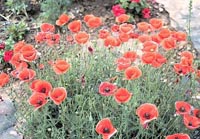Resource Library
Plant of the Week: Poppy (Field Poppy, Flanders Poppy, Corn Poppy)
The University of Arkansas System Division of Agriculture does not promote, support or recommend plants featured in "Plant of the Week." Please consult your local Extension office for plants suitable for your region.
Plant of the Week
Field Poppy, Flanders Poppy, Corn Poppy
Latin: Papaver rhoeas

Given the colossal waste and human suffering that mankind proffers in waging war against neighboring countries, it is not surprising that a floral emblem has emerged to represent the suffering and loss associated with war. The European field poppy has assumed this role for the wars of the 20th century.
The field poppy is an annual flower widely distributed throughout Europe. It grows about 2 feet tall and has delicately textured crepe-textured flowers to 3 inches across held singly aloft on thin stems. Before opening, the olive-sized buds nod downwards as they await their day in the sun. Flower color is variable in the species with over 20 botanical varieties described, but the most common type is red. The red of blood.
The poppy has been associated with war since at least the Battle of Waterloo in 1815 when Duke Wellington of England and the Prussian General Blucher decisively defeated Napoleon on this battlefield in modern day Belgium. By this time the machines of war - especially cannons and the horsepower needed to move them about - were beginning to churn the countryside when a battle took place.
But it was WWI, and especially the battles of the Low Country of Flanders - a province of Belgium, that resulted in the final adoption of the field poppy as the token of war. The story goes that, after heavy fighting in the area had ended, graves were dug and soldiers interred. The following spring when the graves were visited, they were awash in a sea of red poppies - plants that had not been seen in the region for years.
That the poppies appeared after the graves were dug is botanically interesting but not miraculous - at least not in the conventional way. Poppy seeds have a type of secondary dormancy called "photo-dormancy" and require light to germinate. These tiny seeds may lie dormant 25 to 50 years in the soil biding their time until sunlight appears. A pigment called phytochrome intercepts red light rays and begins a cascade of events that leads to germination.
An American, Moina Michael, wrote a poem about poppies and their seemingly miraculous appearance in 1915. She began wearing an artificial poppy made by a French firm. This eventually caught on as a patriotic symbol and was adopted by the English who celebrated their first Poppy Day in 1921 to remember those lost in battle. By 1922 a factory employing disabled war veterans was established in Great Britain to make paper mache poppies. By the late 20's the poppies, sold as boutonnieres or wreaths, had made their way to the US and were sold as a fund raising activity for American war veterans.
In England a company existed into the 1980s to manufacture poppies and still had about 180 employees at that time - still staffed by disabled but not necessarily disabled veterans. The practice of selling paper mache poppies for a dime was common in my grade school days. When I relate this story to college kids of today, they show no signs of recognition so the practice seems to have stopped.
The field poppy has escaped cultivation in North America but does not appear to survive long term in the South. It is often used as a part of a wildflower mix that is seeded in the fall with blooms appearing in mid spring the following year. Poppies transplant poorly so it is usually best to plant the seeds where they are intended to grow.
By: Gerald Klingaman, retired
Extension Horticulturist - Ornamentals
Extension News - March 23, 2001
The University of Arkansas System Division of Agriculture does not maintain lists of retail outlets where these plants can be purchased. Please check your local nursery or other retail outlets to ask about the availability of these plants for your growing area.